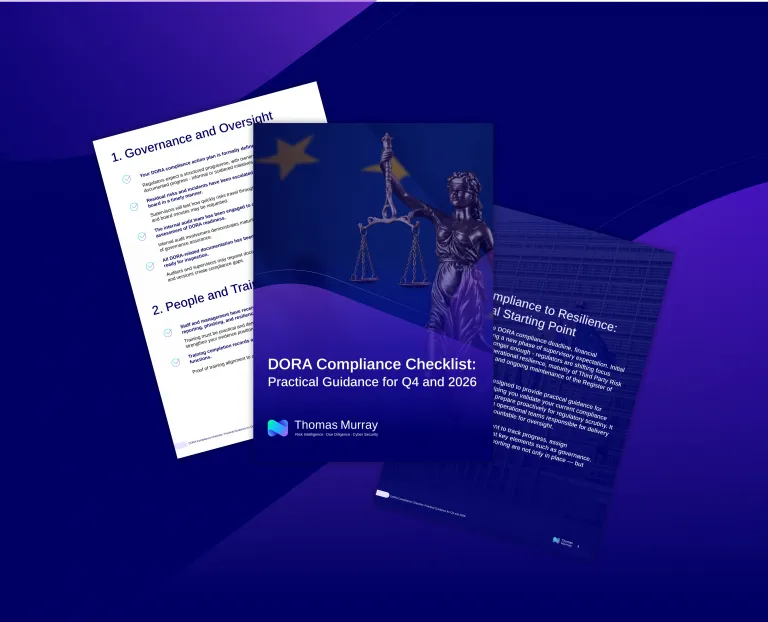Information current as at 17 July 2025
This newsletter features a carefully curated range of timely news stories and significant industry updates from across the institutional digital asset ecosystem. Our opening selection draws directly from Thomas Murray’s proprietary market intelligence, curated exclusively for clients as part of our comprehensive monitoring solutions. The following highlights are selected industry developments, providing wider market context and actionable insights we consider valuable for industry professionals.
Thomas Murray's Generated Insights
Eurosystem Expands DLT Settlement Initiative
The European Central Bank (ECB) has approved a plan to facilitate the settlement of distributed ledger technology (DLT) transactions using central bank money. The dual-track approach includes a short-term pilot phase (Pontes) and a long-term plan (Appia), for a future-ready integrated ecosystem in Europe.
The ECB aims to explore the feasibility of DLT technologies for Eurosystem settlement and gain public and private stakeholder input through Market contact groups. These are dedicated forums established by the ECB to facilitate continuous and structured dialogue between the ECB, financial market stakeholders, and other relevant actors. The initiative is expected to have a significant impact on the European financial sector and will provide a new settlement option for financial institutions and market participants.
During the Pontes pilot phase, the Eurosystem will also explore the feasibility of further enhancements in line with the TARGET Services operational, legal and technical standards. In addition, requests for further DLT-related trials and experiments will also be considered.
KDPW to Introduce New DLT-Based Depository and Settlement Layer
KDPW, the Polish Central Securities Depository (CSD), has announced the development of the CSDonDLT project, an additional DLT-based layer that is integrated within the current depository and settlement system.
The current and initial focus of the project is on the settlement of OTC transactions using blockchain, with the safekeeping, transfer, and atomic settlement of securities to occur within the new DLT layer.
To support this, KDPW has signed a cooperation agreement with StaBillion, an on/off fiat ramp for digital assets, and will provide e-money tokens for the project. KDPW is also inviting other capital market institutions to participate.
Regulation on Digital Ruble Adopted
The Central Bank of Russia (CBR) has announced the staged introduction of the digital ruble. From September 1, 2026, major banks will be required to allow clients to make transactions using a digital ruble.
The new digital currency will need to be adopted by all banks and companies with annual revenues over RUB 30 million (US$382,173) by 1 September 2027, with all others by 1 September 2028.
The introduction of the digital ruble is expected to have a significant impact on the Russian financial sector, providing a new payment option for consumers and businesses. The digital ruble is also expected to help reduce the use of cash and increase the efficiency of the payment system.
Legislative Council of Hong Kong Passes Stablecoins Ordinance
The Legislative Council of Hong Kong has passed the Stablecoins Ordinance, which establishes a licensing regime for fiat-referenced stablecoin issuers.
The Ordinance requires Stablecoin issuers to demonstrate adequate competencies and experience across a range of areas, including:
- the management and security of reserve assets
- effective price stabilisation mechanisms
- comprehensive and feasible redemption policies
- technological security, risk management, and anti-money laundering capabilities.
Expected to come into effect from August 1, 2025, the ordinance is designed to provide a regulatory framework for the stablecoin market, which has grown significantly in recent years. The licensing regime will help to ensure that stablecoin issuers operate safely, and that investors are protected from potential risks.
The Hong Kong Monetary Authority (HKMA) is expected to begin accepting licence applications once the ordinance takes effect.
ADX Launches First Digital Bond
The Abu Dhabi Securities Exchange (ADX) has commenced the pricing stage for listing the DLT-based bond in the MENA region. The bond, to be issued by First Abu Dhabi Bank (FAB), will be listed on ADX and made available on HSBC’s Orion platform.
Global investors will be able to access the digital bond through accounts held with Euroclear, Clearstream, or the Central Moneymarkets Unit (CMU). This milestone marks a significant step towards the adoption of digital assets in the region.
Additional Noteworthy Market Developments
SDX and Pictet Group Complete Pilot Project for Tokenised Corporate Bonds
Six Digital Exchange (SDX), a regulated digital asset exchange and Central Securities Depository (CSD) built using DLT has completed a pilot project with Pictet, a Swiss multinational private bank. The pilot demonstrated the potential of tokenisation and fractionalisation in transforming fund management.
The project involved the tokenisation of corporate bonds, enabling fractional quantities to be allocated to individual portfolios, managed by Pictet Asset Management. This innovative approach demonstrated how tokenising bonds allows for greater customisation and personalisation of client portfolios, as well as increased diversification through the ability to fractionalise an asset. Olivier Ginguené, Chief Investment Officer for Asset Allocation and Quantitative Investments at Pictet Asset Management, highlighted the significance of this project, stating that it offers "customisation at scale."
Australia to Commence Trials of Tokenised Asset Settlement and CBDC
Fourteen participants have been selected to undertake trials of tokenised asset settlement in financial markets as part of Project Acacia, a joint initiative between the Reserve Bank of Australia (RBA) and the Digital Finance Cooperative Research Centre (DFCRC).
Twenty-four innovative use cases, and a diverse range of organisations, ranging from local fintechs to major banks, have been conditionally selected for this next stage of the project. This will include nineteen pilot use cases involving real money and real asset transactions, and five proofs of concept involving simulated transactions.
The use cases involve a range of asset classes, including fixed income, private markets, and carbon credits, and examples of the proposed settlement assets include stablecoins and central bank digital currency (CBDC).
This initiative aims to explore the potential of tokenisation and CBDC in improving the efficiency and speed of cross-border payments. It will be tested against a range of different DLT environments, including private and public-permissioned platforms, such as Hedera, R3’s Corda, and other EVM-compatible networks.
European Watchdog Warns of Inadequate Malta Crypto Licensing
The European Securities and Markets Authority (ESMA) has raised concerns over Malta's handling of licensing approvals under the EU's Markets in Crypto-Assets regulation (MiCAR). A recent report highlighted deficiencies in Malta’s Financial Services Authority's (MFSA) authorisation process, citing an inadequate risk assessment framework with outstanding material issues.
ESMA has urged tighter oversight by the MFSA, to ensure compliance with MiCA’s standards. Furthermore, the warning highlights the need for regulatory bodies to work together to ensure consistent and effective implementation of regulations across the EU.
BNY Mellon Selected for Ripple USD Reserve Custody
Ripple, a leading provider of digital asset infrastructure for financial institutions, has announced that The Bank of New York Mellon Corporation (BNY Mellon) will serve as the primary custodian of its reserves for its Ripple USD (RLUSD) stablecoin. This coin is designed for enterprise-grade financial use cases.
Stablecoin reserves, which are pools of assets, such as U.S. dollars, cash equivalents, and short-term treasuries fully back the value of a stablecoin like RLUSD, ensuring each token issued maintains a 1:1 peg with the underlying fiat currency.
BNY Mellon will leverage its expertise and technology stack to provide custody services for RLUSD. The partnership is expected to provide a secure and reliable way for financial institutions to hold and manage digital assets, which is critical for the widespread adoption of digital assets. Additionally, the partnership demonstrates the growing recognition of the importance of digital assets in the financial sector and the need for secure and reliable infrastructure and custody to safeguard their investment and use.

Digital Asset Custodian Monitoring
Our DACM solution sets a standard for transparency and risk intelligence in digital markets. Against an industry that is complex, fragmented, unstandardised, and fraught with cyber risk, our solution provides you with the tools and insights to effectively evaluate, select and monitor your digital asset custodian.
Let’s Talk
Interested in strengthening your approach to digital asset custody?
Get in touch to request a demo, or to talk to one of our experts to find out how Thomas Murray can support your risk evaluation, monitoring, and strategy execution in the digital asset space.
Insights

5 Key Takeaways from a Deal Hacker: What PE Firms Should Look for When Doing Cyber Deal Due Diligence
Are your private equity deals safe from cybercriminals? The answer is very much ‘no’. Deals are being compromised, money is being lost, and reputations are being affected.

Why Cybersecurity Due Diligence is Critical to Deal Completion
It’s a common story: after months of meticulous financial, operational, and market analysis, a critical finding emerges in the final weeks before deal closure – threatening what seemed like a near-certain transaction with a three-month delay.

Ransomware at Europe’s Airports: Case for Community-Driven Third Party Risk Management
The recent ransomware attack on Collins Aerospace’s Muse software, which brought chaos to airports across Europe, serves as a stark reminder of a critical gap in how organisations approach Third Party Risk Management (TPRM).


